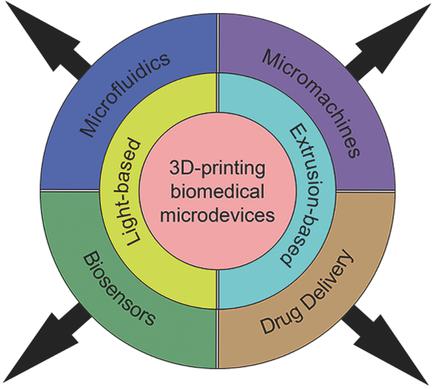当前位置:
X-MOL 学术
›
Small Methods
›
论文详情
Our official English website, www.x-mol.net, welcomes your
feedback! (Note: you will need to create a separate account there.)
3D‐Printing of Functional Biomedical Microdevices via Light‐ and Extrusion‐Based Approaches
Small Methods ( IF 10.7 ) Pub Date : 2017-12-19 , DOI: 10.1002/smtd.201700277 Henry H Hwang 1 , Wei Zhu 1 , Grace Victorine 1 , Natalie Lawrence 1 , Shaochen Chen 1
Small Methods ( IF 10.7 ) Pub Date : 2017-12-19 , DOI: 10.1002/smtd.201700277 Henry H Hwang 1 , Wei Zhu 1 , Grace Victorine 1 , Natalie Lawrence 1 , Shaochen Chen 1
Affiliation

|
3D‐printing is a powerful additive manufacturing tool, one that enables fabrication of biomedical devices and systems that would otherwise be challenging to create with more traditional methods such as machining or molding. Many different classes of 3D‐printing technologies exist, most notably extrusion‐based and light‐based 3D‐printers, which are popular in consumer markets, with advantages and limitations for each modality. The focus here is primarily on showcasing the ability of these 3D‐printing platforms to create different types of functional biomedical microdevices—their advantages and limitations are covered with respect to other classes of 3D‐printing, as well as the past, recent, and future efforts to advance the functional microdevice domain. In particular, the fabrication of micromachines/robotics, drug‐delivery devices, biosensors, and microfluidics is addressed. The current challenges associated with 3D‐printing of functional microdevices are also addressed, as well as future directions to improve both the printing techniques and the performance of the printed products.
中文翻译:

通过基于光和挤压的方法 3D 打印功能性生物医学微型设备
3D 打印是一种强大的增材制造工具,可以制造生物医学设备和系统,而使用机械加工或成型等更传统的方法很难制造这些设备和系统。存在许多不同类别的 3D 打印技术,最引人注目的是基于挤出和基于光的 3D 打印机,它们在消费市场中很受欢迎,每种模式都有优点和局限性。这里的重点主要是展示这些 3D 打印平台创建不同类型的功能性生物医学微型设备的能力 - 涵盖了它们相对于其他类别 3D 打印的优势和局限性,以及过去、最近和未来努力推进功能性微器件领域。特别是微型机械/机器人、药物输送装置、生物传感器和微流体的制造。还解决了当前与功能性微型设备 3D 打印相关的挑战,以及改进打印技术和打印产品性能的未来方向。
更新日期:2017-12-19
中文翻译:

通过基于光和挤压的方法 3D 打印功能性生物医学微型设备
3D 打印是一种强大的增材制造工具,可以制造生物医学设备和系统,而使用机械加工或成型等更传统的方法很难制造这些设备和系统。存在许多不同类别的 3D 打印技术,最引人注目的是基于挤出和基于光的 3D 打印机,它们在消费市场中很受欢迎,每种模式都有优点和局限性。这里的重点主要是展示这些 3D 打印平台创建不同类型的功能性生物医学微型设备的能力 - 涵盖了它们相对于其他类别 3D 打印的优势和局限性,以及过去、最近和未来努力推进功能性微器件领域。特别是微型机械/机器人、药物输送装置、生物传感器和微流体的制造。还解决了当前与功能性微型设备 3D 打印相关的挑战,以及改进打印技术和打印产品性能的未来方向。










































 京公网安备 11010802027423号
京公网安备 11010802027423号